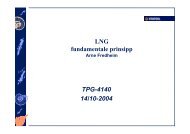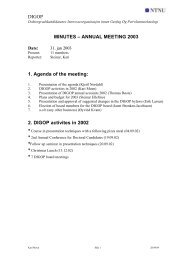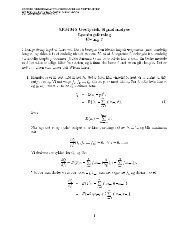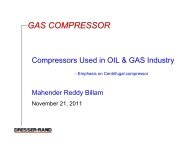Slug Catchers in Natural Gas Production - NTNU
Slug Catchers in Natural Gas Production - NTNU
Slug Catchers in Natural Gas Production - NTNU
You also want an ePaper? Increase the reach of your titles
YUMPU automatically turns print PDFs into web optimized ePapers that Google loves.
Karam – <strong>Slug</strong> <strong>Catchers</strong> <strong>in</strong> <strong>Natural</strong> <strong>Gas</strong> <strong>Production</strong><br />
ABSTRACT<br />
Operations <strong>in</strong> deep, far and remote areas as well as cold environments have raised the problem of slug<br />
formation. Irregular sea floor is the ma<strong>in</strong> concern and major reason beh<strong>in</strong>d the formation of these slugs. Their<br />
presence <strong>in</strong> the pipel<strong>in</strong>es has raised the flow assurance concerns. Several methods are used to <strong>in</strong>hibit such<br />
occurrences as the use of MEG besides the erection of slug catchers at the receiv<strong>in</strong>g term<strong>in</strong>als. The design of<br />
the latter challenges eng<strong>in</strong>eers due to the difficulty of predict<strong>in</strong>g accurately slug length and volumes.<br />
The project will focus on the design of slug catchers and then on four different field cases ly<strong>in</strong>g <strong>in</strong> the<br />
Norwegian Cont<strong>in</strong>ental Shelf. The analysis of a set of articles and theses made it possible to gather the needed<br />
<strong>in</strong>formation. HYSYS was one tool <strong>in</strong> hand to calculate the gas, liquid and condensate fractions <strong>in</strong> the models.<br />
Input data to the model were either assumed, found from previous literature work or calculated from several<br />
correlations.<br />
The project deliberates about two major parts. The first focuses on multiphase flow problems and slug<br />
formation along with the different types of slug catchers available. As for the second part, the methods beh<strong>in</strong>d<br />
the design of a slug catcher are brought <strong>in</strong>to light. A HYSYS simulation was associated with the model to<br />
verify the percentage of the different phases and check whether the size of the slug catcher is suitable.<br />
As a result, the design of a slug catcher was dependent upon three major parameters. These are the length and<br />
the <strong>in</strong>cl<strong>in</strong>ation of the f<strong>in</strong>gers of the multi-pipe catcher, the diameter of the pipel<strong>in</strong>e head<strong>in</strong>g to the <strong>in</strong>let of the<br />
slug catcher and the liquid accumulation volumes expected to be formed <strong>in</strong> the pipel<strong>in</strong>es. The analysis showed<br />
that the multi-pipe type is the mostly used especially for large slug volumes.<br />
Regard<strong>in</strong>g the simulations, HYSYS is not an accurate tool for multiphase flow analysis and estimation of<br />
phase volumes due to the limitations of the program and the simplifications assumed. The MEG quantity<br />
<strong>in</strong>jected was smaller than what is actually used <strong>in</strong> the fields. Likewise, the volume or size of the slug catchers<br />
should be smaller than their current size; this discrepancy is due to the larger amount of slug expected to be<br />
formed and to the simplifications attributed to the model.<br />
Page ii of viii

















